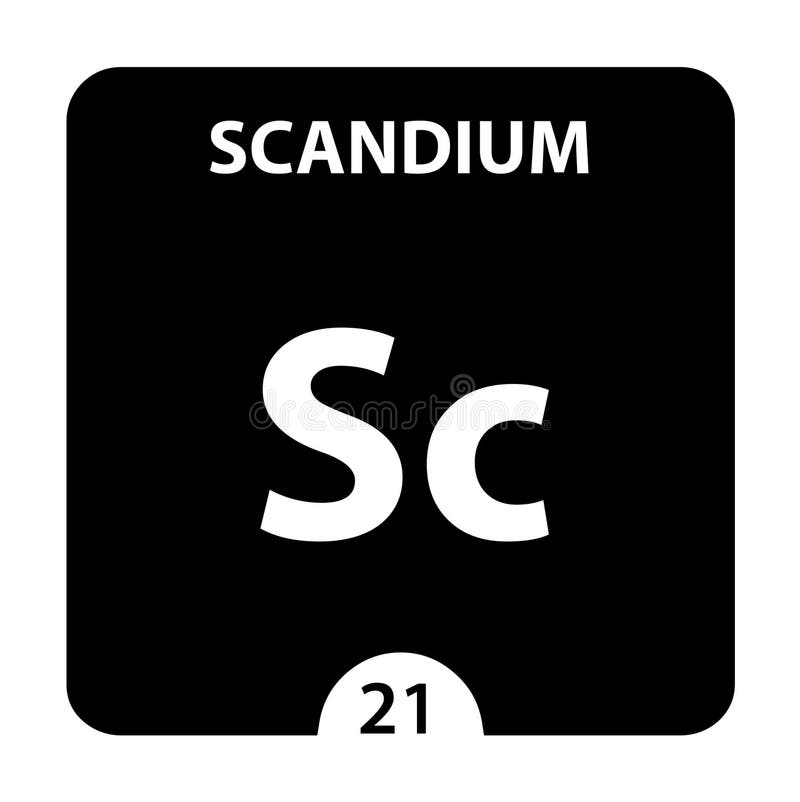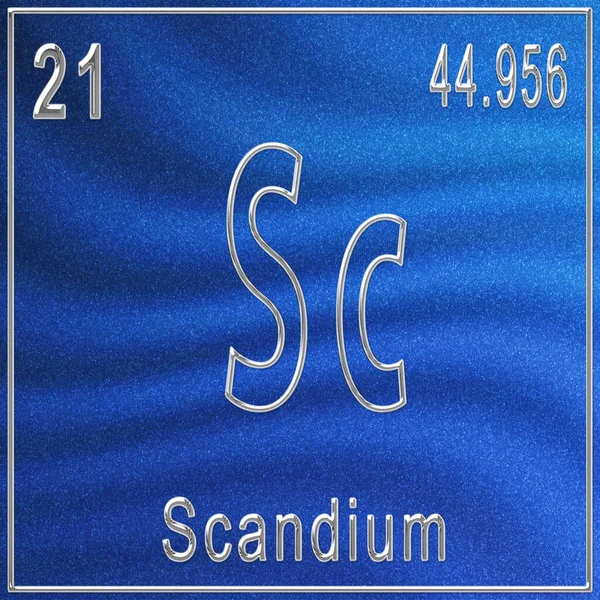We elaborate the uses of Scandium and atomic properties with characteristics. Scandium is a silver-white chemical element with an atomic number of 21. Its symbol is Sc and it belongs to the group of transition metals and its usual state in nature is solid. Scandium is located at position 21 on the periodic table.
You Can Visit Our Managed: Periodic Table Main Page

The atomic number of scandium is 21. Like any other element from group IIIB of the periodic table, it has a valency of 3. In other words, during a chemical reaction, when it combines with other elements, it loses three electrons from in its outermost shell (or valence shell). Scandium (Sc) Atomic Data for Scandium (Sc) Atomic Number = 21 Atomic Weight = 44.955910 Reference E95: Isotope: Mass: Abundance: Spin: Mag Moment: 45 Sc. Our scandium page has over 180 facts that span 86 different quantities. Each entry has a full citation identifying its source. Areas covered include atomic structure, physical properties, atomic interaction, thermodynamics, identification, atomic size, crystal structure, history, abundances, and nomenclature. Scandium (Sc) has the atomic number 21. Scandium has 24 neutrons, 21 protons, and 21 electrons (unless otherwise designated).The electron configuration for Scandium is Ar4s^2 3d^1 What is the.
On this page you can discover the chemical properties of scandium and information about scandium and other elements on the periodic table such as yttrium, calcium, titanium or vanadium. You will also learn what scandium is for and you will learn about its uses through its properties associated with scandium such as its atomic number or the usual state in which scandium can be found.

You can see qualities of scandium such as its melting and boiling point, its magnetic properties or what its chemical symbol is. In addition, here you will find information about its atomic properties such as the distribution of electrons in scandium atoms and other properties.
The number of protons determines the element, but the number of neutrons in the atom of any one element can vary. Each variation is an isotope. About 10 radioactive isotopes of scandium are known also.
For some elements, some of this information is unknown. In these cases we show the properties attributed to them.
Scandium properties

Transition metals, also called transition elements is the group to which the scandium belongs. In this group of chemical elements to which the scandium belongs, there are those located in the central part of the periodic table, specifically in block d. Among the characteristics that scandium has, as well as those of the rest of the transition metals, is that of including in its electronic configuration the d orbital, partially full of electrons. Properties of this type of metal, among which is scandium, are its high hardness, having high boiling and melting points and being good conductors of electricity and heat.
The state of the scandium in its natural form is solid. Scandium is a silver white chemical element and belongs to the group of transition metals. The atomic number for scandium is 21. The chemical symbol for scandium is Sc. The melting point for scandium is 1814 degrees Kelvin or 1541.85 degrees celsius or degrees centigrade. The boiling point of scandium is 3103 degrees Kelvin or 2830.85 degrees Celsius or degrees Celsius.
Uses of scandium
Scandium is element 21 on the periodic table and is represented by the symbol Sc. It was discovered by Lars Fredrik Nilson in 1879. In its pure form it is silver-white in color and is solid at room temperature. It is commonly produced as a by-product during the extraction of uranium and iron . World production remains low, reducing applications of this chemical element. If you’ve ever wondered what scandium is for , here is a list of its possible uses:
- Scandium is added to aluminum to create a very strong alloy that is used in the aerospace industry. The Russian military aircraft MiG-21 and MiG-29 use this material. Due to the high cost, titanium alloys are used more frequently in aircraft.
- Scandium alloys are also used in some high performance sports equipment. This includes baseball bats, bicycle chains, and lacrosse sticks. There is at least one weapons manufacturing company that uses scandium alloys in its revolvers.
- Scandium Iodide is used with sodium iodide to create gas lamps. They are a powerful light source and are commonly used to replicate sunlight when using television cameras.
- On oil platforms, a radioactive isotope of scandium is used as a tracing agent to aid in the analysis of crude oil.

Atomic properties of scandium
The atomic mass of an element is determined by the total mass of neutrons and protons that can be found in a single atom belonging to this element. As for the position where to find the scandium within the periodic table of the elements, the scandium is in group 3 and period 4. The scandium has an atomic mass of 44.955910 u.
The electronic configuration of the scandium is [Ar] 4s2 3d1. The electronic configuration of the elements, determines the form in which the electrons are structured in the atoms of an element. The mean radius of the scandium is 160 pm, its atomic radius or Bohr radius is 184 pm, and its covalent radius is 144 pm.
You Can Visit Our Managed: Periodic Table Main Page
Scandium Characteristics
Melting Point Of Scandium
Below you can see a table showing the main characteristics of the scandium.
How Many Electrons Are In Scandium
| Scandium | ||
|---|---|---|
| Chemical symbol | Sc | |
| Atomic number | twenty-one | |
| Group | 3 | |
| Period | 4 | |
| Appearance | silver white | |
| Block | d | |
| Density | 2985 kg / m3 | |
| Atomic mass | 44.955910 u | |
| Average radius | 160 pm | |
| Atomic radio | 184 | |
| Covalent radius | 144 pm | |
| Electronic configuration | [Ar] 4s2 3d1 | |
| Oxidation states | 3 | |
| Oxide | weak base | |
| Crystal structure | hexagonal | |
| State | solid | |
| Melting point | 1814 K | |
| Boiling point | 3103 K | |
| Heat of fusion | 14.1 kJ / mol | |
| Vapor pressure | 22.1 Pa to 1812 K | |
| Electronegativity | 1.36 | |
| Specific heat | 568 J / (K · kg) | |
| Electric conductivity | 1.77 × 106S / m | |
| Thermal conductivity | 15.8 W / (Km) | |
How Many Shells Does Scandium Have
You Can Visit Our Managed: Periodic Table Main Page
